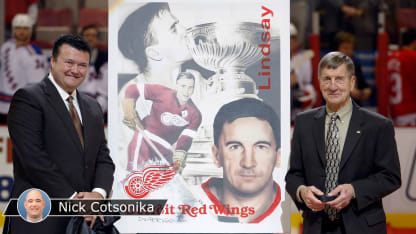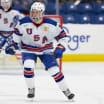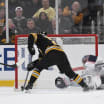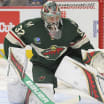"He'd come in and work out," said Devellano, now Red Wings senior vice president. "He was a fitness freak. But he loved to be around the players. He loved to be around hockey people. He was just really a hockey guy."
Lindsay made an impression when the Winnipeg Jets traded forward Jim Nill to the Red Wings in 1988.
"You're at practice, and you're working out," said Nill, who worked in the Red Wings front office from 1994-2013 and is now general manager of the Dallas Stars. "All of a sudden, you look, and that's Ted Lindsay. And there he is in the weight room. … It's almost like you say, 'When I grow up, I want to be like that guy. … Boy, he's got something. I want part of that.' "
Even someone like Mark Howe revered Lindsay. Howe was the son of Gordie Howe, Mr. Hockey, Lindsay's old linemate, and he was a defenseman on his way to the Hockey Hall of Fame himself.
"I was 38, 39, 40 years old," said Howe, who played for the Red Wings from 1992-95 and now scouts for them. "Ted Lindsay walks in the room, and you just stand up, you walk over, you go shake his hand. 'Good morning. How you doing?' It's neat, if you have any respect for history or the past. My thinking is, how can you not?
"He was a vicious, vicious competitor and a (heck) of a hockey player. I think it was pretty awesome to have a guy like that in the locker room."
Boyer joined the Red Wings in 1994. A couple of years later, he visited the Detroit Tigers and saw how they used nameplates of icons like Ty Cobb and Al Kaline when stalls were empty in the clubhouse. He replicated that.
The difference with Lindsay was that he actually was still using the locker.
"He was really happy to be around the dressing room, because he never left it," said Scotty Bowman, who coached the Red Wings from 1993-2002 and is now a senior adviser with the Blackhawks. "When I was there, he was there every day.
"I used to see him working out in the gym. I used to kid him. I said, 'I know you're not going to make another comeback, but try to get some more guys in here.' He liked that. He was proud. He was something."
When Mike Babcock coached the Red Wings from 2005-15, he would include Lindsay in team meetings. Once, he had Lindsay do a "family day," canceling the morning skate so Lindsay could share pictures of growing up in the mining town of Kirkland Lake, Ontario, and playing in the old NHL.
Listen to how Babcock refers to him.
"Mr. Lindsay was a real good friend of mine and an example to all of us," said Babcock, now coach of the Toronto Maple Leafs. "He made you want to be a better man. He made our players in Detroit want to compete harder."


















